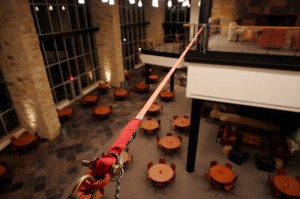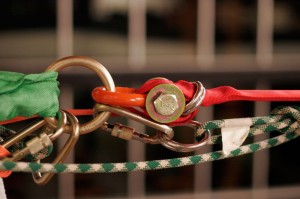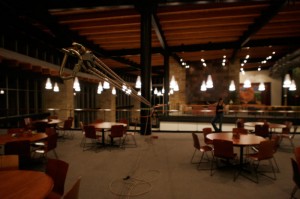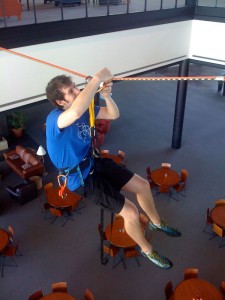Epic Highline
Rigging beta contained within. Do not rig highlines if you don’t know what you’re doing. You will die if you setup something incorrectly. If you’re not experienced, learn from someone who is. If you’re in the NW and want to watch/learn/walk a highline, drop me an e-mail.
 I finally had a chance to rig the highline I posted about a few weeks ago. It’s approx 35ft across, 40 feet off the deck. The primary anchors are two-foot-thick concrete pillars, so there is no need for backup anchor points (which is nice, for the sake of simplicity). Standard warning applies regarding all of the following info.
I finally had a chance to rig the highline I posted about a few weeks ago. It’s approx 35ft across, 40 feet off the deck. The primary anchors are two-foot-thick concrete pillars, so there is no need for backup anchor points (which is nice, for the sake of simplicity). Standard warning applies regarding all of the following info.
I used 8ft endless loop roundslings (“spansets” as they are known amongst highliners) for each anchor. The tri-load at the rigging point causes a 50% reduction in break strength, but since the slings were configured in basket (200% strength), the two multipliers basically cancel out. The slings are rated for 6400lb WLL, which I consider adequate (5:1 safety factor, and no one to my knowledge has yet to exceed 4000lbs of total force [including the residual tension], on a dynomometer equipped highline). The master rigging point on the tension side was a 50Kn forged three inch ring. To this was attached a 5/8″ CM shackle. The static side was directly connected to a 5/8″ CM shackle. Shackles on both sides were “bolt, nut, cotter” style, with the original hardware replaced by Grade 8 bolts/nuts/washers. Both shackles were sleeved with two-inch tubular webbing (example) to prevent line abrasion and locker drift. The main line was Type18 (1″ flat webbing) from Yates, which has recently been pull tested to excess of 7,000 lbs break strength. (Here is a photo of Type18 vs Tubular, with T18 on bottom) Because of the strength of Type18, a single backup was used (a dynamic 10mm climbing rope), which was tied into the rig points via a figure eight around two steel rap rings (per side), and then tied into the main anchors as a loose backup in case something in the main rigging (e.g. anchor sling) failed. Steel hardware (rings, carabiners, shackles) was used everywhere.
As you can see by the image on the right (above), I used a second pillar, 25 feet behind (and slightly off-angle) the tension side pillar, as the tensioning system anchor. After the main line was pulled to proper tension, I soft-pointed this to the round sling on the main pillar (allowing removal of the tensioning system).
This is the cleanest highline I’ve rigged so far, since it needed no backup anchorage, only one backup line, and had the tensioning system completely removed once pulled taut. In the [cameraphone] photo below, you can see me taping the backup and main line together, just before go-time.




Ahh. Do you know where to get those 3 inch rigging rings in Seattle? I’m looking for a couple to take home to Australia with me.
EDIT: I just emailed you, but for anyone else wondering, I bought mine from RenoB (renobclimbing.com). Sidenote: his 44Kn rated steel rings are probably NOT 44Kn rated (I have significantly deformed them at around 5-8Kn).